Pici or Pinci are long, thick, rustic Tuscan noodles that are approximately the thickness of a pencil. They have a fantastic chewy texture from the combination of semolina and all-purpose flours.
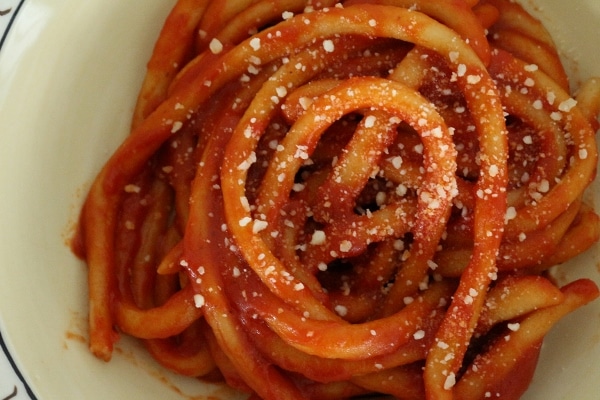
I love working with dough. Whether it's while baking fresh bread, shaping Asian dumplings, pleating pie crust, or rolling fresh pasta or gnocchi. There's something truly therapeutic about kneading, rolling, and/or shaping dough.
Making gnocchi or other hand-shaped pasta is a wonderful experience. Believe it or not there are so many different kinds depending on the region or even village in Italy. It's interesting to see how different these little dumplings are based on geographic location.
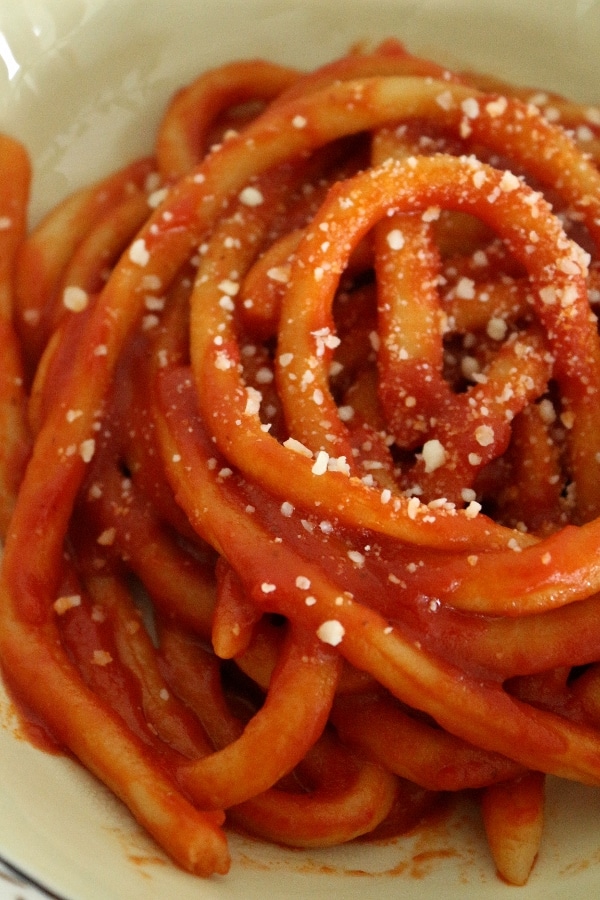
Tuscany, for example, is where pici derives from. The dough is rolled out flat, and then cut into strips before rolling each to yield long, imperfect strands.
Think of them as super thick hand-rolled spaghetti. They are considerably chewy due to the combination of semolina and all-purpose flours. Whether you call then pinci or pici, these are a cross between dumplings and noodles, and they are certainly delicious!
Because they are quite hearty, a serving size of pici is moderate. You can serve this as a first course to a larger meal or make it the star of the menu with some supplementary sides.
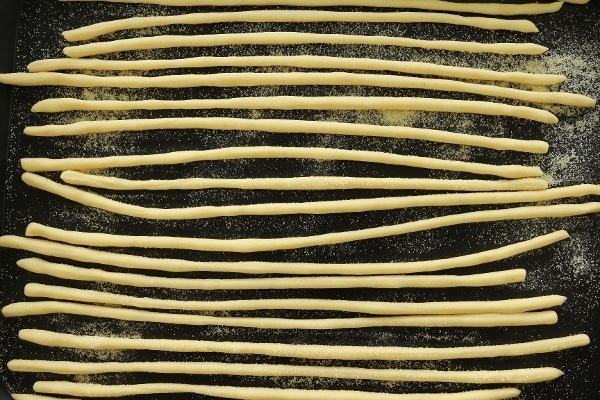
Traditionally served with tomato sauce or meat ragu, pici are fun to make and even more fun to eat. I made a decadent tomato sauce emulsified with butter, and infused with onion, garlic, and a bit of rosemary.
The sauce is velvety smooth, and cloaks the noodles beautifully. Both the pici and sauce freeze well for nearly-last-minute weeknight meals.
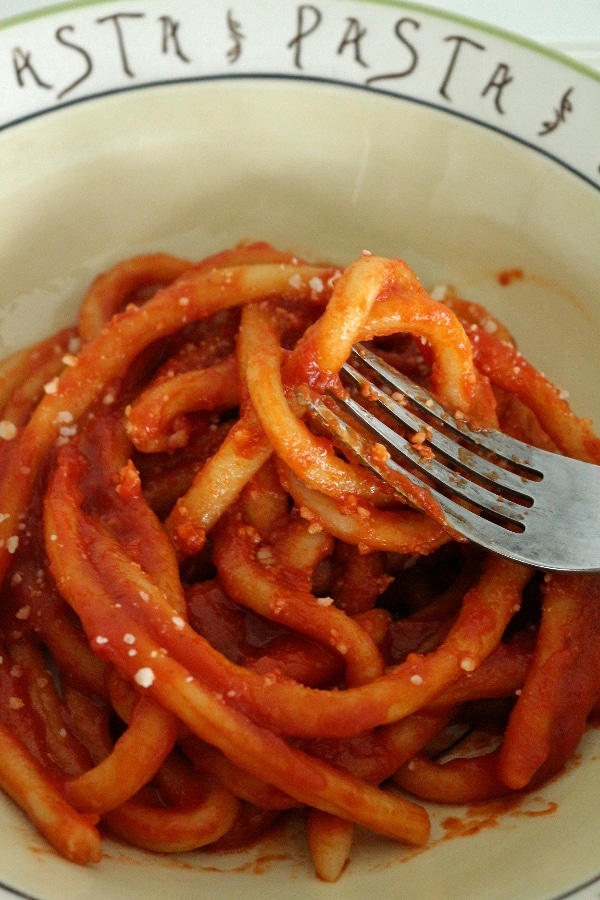
Other recipes you may like
- Gnocchi al Sagrantino all’Amatriciana
- Ricotta Cavatelli
- Dunderi with Lemon and Butter
- Spinach and Ricotta Gnudi with Tomato-Butter Sauce
- Schupfnudeln (German Potato Noodles)
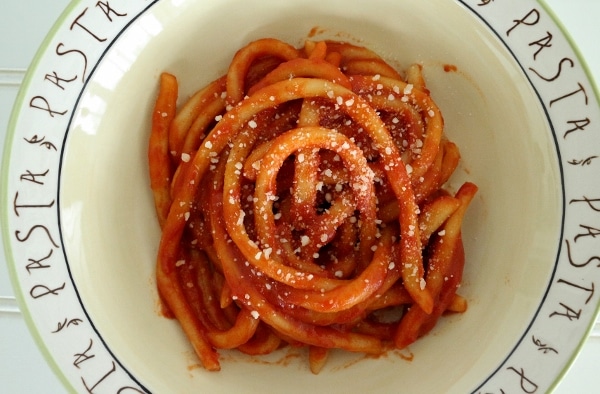
Tried this recipe? Please leave a star ⭐️⭐️⭐️⭐️⭐️ rating in the recipe card below and/or a review in the comments section further down the page. You can also follow me on social media on Facebook, Instagram, and Pinterest!
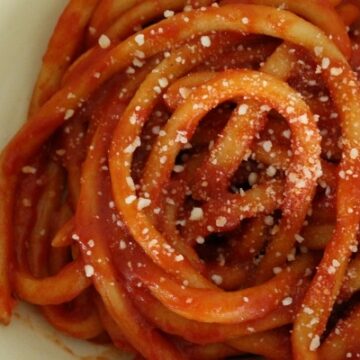
Pici (Pinci) Pasta
Ingredients
Pici:
- 255 grams (1 ½ cups) semolina flour plus more for dusting
- 255 grams (1 ¾ cups + 2 tablespoons) all-purpose flour
- 2 teaspoons kosher salt
- 255 grams (1 cup + 1 tablespoon) warm water plus more as needed
Tomato Sauce:
- 2 tablespoons extra-virgin olive oil
- 4 large garlic cloves halved
- ½ large yellow onion sliced
- Leaves from 1 sprig fresh rosemary
- 1 bay leaf
- ½ teaspoon red pepper flakes
- 6 cups (1.2 kg) canned whole peeled tomatoes, pureed and strained, or crushed tomatoes
- 115 grams (½ cup) unsalted butter, cut into small cubes, plus more for serving (I omit the extra for serving)
- Kosher salt
Instructions
Pici:
- In a large bowl or the bowl of a stand mixer fitted with a dough hook attachment, combine the semolina flour, all-purpose flour, and salt at medium speed. Add the water and stir with a wooden spoon or mix on medium speed until a cohesive but not sticky dough forms, 1 to 2 minutes. Add more water, 1 tablespoon at a time, and knead with your hands or on medium speed until the dough is smooth and soft without being sticky or dry, about 8 minutes more. Cover the dough with plastic wrap and let rest at room temperature for 1 hour.
- Line two baking sheets with parchment paper and dust with semolina flour. With a rolling pin, roll the dough on an unfloured work surface into a flat sheet ¹⁄8 inch (4 mm) thick, and then cut into ¹⁄8-inch- (4-mm-) wide strips. With your hands, roll one strip back and forth on the work surface into a fat spaghetti-like strand. Put the pici on the prepared baking sheets and shape the remaining dough. Make sure that the pici don’t touch or they will stick together. (To store, refrigerate on the baking sheets, covered with plastic wrap, for up to 2 days, or freeze on the baking sheets and transfer to an airtight container. Use within 1 month. Do not thaw before cooking.)
Tomato Sauce:
- In a medium pot, warm the olive oil over medium heat. Add the garlic, onion, rosemary, bay leaf, and red pepper flakes and cook until the onion is translucent, about 10 minutes. If the onion begins to brown, lower the heat. Add the tomatoes and butter and simmer, stirring occasionally, until the sauce is slightly thick and soft but not pasty, about 45 minutes. The butter should emulsify into the sauce. Season with salt. Set a fine-mesh strainer over a large bowl and pour the sauce into the strainer. Discard the solids in the strainer. (To store, transfer to an airtight container and refrigerate for up to 2 days, or freeze for up to 1 month. To thaw, place in the refrigerator overnight or until fully thawed.)
To Finish:
- Bring a large pot filled with generously salted water to a simmer over medium-high heat. Add the pici and simmer until they float to the surface, 1 to 3 minutes. Simmer until slightly al dente, 1 to 2 minutes more. Remove immediately with tongs and finish with tomato sauce.
- For each serving, warm about ½ cup (120 ml) of the tomato sauce in a sauté pan over medium heat. Add 1 ½ teaspoons to 1 tablespoon butter per serving, depending on how naughty you feel, and gently simmer until the bubbles get large and the sauce is not watery along the edges of the pan. The sauce should be thick and silky, not dry or pasty. Add the cooked pici and simmer for 1 minute to let them absorb the flavor of the sauce. Spoon into serving bowls and top with grated Parmigiano-Reggiano. Serve right away.
Notes
- This recipe uses kosher salt (aka cooking salt, kitchen salt, coarse salt outside of the US). If you are using table salt, definitely scale down the salt as that is a saltier type of salt! The type of salt will make a big difference in how salty your food tastes, so keep that in mind.
Nutrition
*All nutritional information is based on third-party calculations and should be considered estimates. Actual nutritional content will vary with brands used, measuring methods, portion sizes and more.*

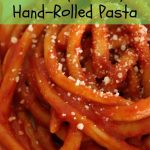
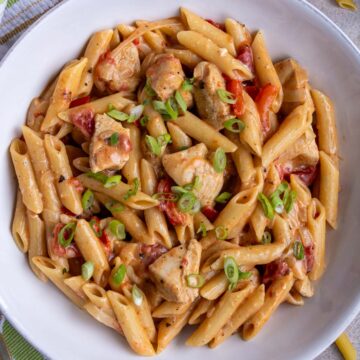



Comments
No Comments